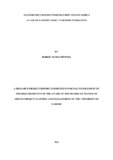| dc.description.abstract | Food security has been and will continue to be on global agenda even as the world population
is expected to hit 9 billion mark by 2050. More than 870 people globally are food insecure.
The Sub-Saharan Africa, is chronically food insecure. At the East Africa Community (EAC)
level, a region which is faced by perennial droughts, efforts are made to reverse the food
insecurity status of the region. Food insecurity war has been faced by numerous challenges,
for instance, poor policy implementation, evidenced by the poor adoption of African states
and governments of the Maputo declaration, which requires allocation to the agricultural
sector 10% of the public spending. Other challenges include, climate change, increasing
global population, poor resource allocation to the ministries of Agriculture by governments,
ever increasing inputs prices, lack of agriculture credit, lack of extension services, poor
marketing of agricultural produce, among others. It is against the backdrop of the global food
insecurity, that this study sought to find out factors influencing food security in EAC. The
objectives of the study were to determine the influence of agricultural inputs, agricultural
budget, agricultural policy implementation on food security in the region. The study looked at
previous literature and identified the knowledge gaps. Theoretical framework looked at
models used in policy implementation whereas conceptual framework elaborates the
relationship among the variables such as dependent, independent, moderating and intervening
variables. Operation definition of variables was also used to make the variables measurable.
The target population was the Eastern Africa Farmers Federation 13 national farmer
organization in EAC. The sample size was 13, whereas the sampling technique applied is
censors, since the entire population was studied. Data was collected using questionnaires and
analysis done using SPSS. Analysed data was then presented using APA tables. In the
analysis, correlation and regression models were done to show the relationship among the
variables. Finally, conclusion and recommendations as well as suggestions further studies are
given. After data analysis, it is concluded that there is relationship between food security and
agricultural resource allocation, agricultural inputs, agricultural credit as well as the
agricultural policy implementation. It is then recommended that agricultural budget need to
be increased, input prices reduced, agricultural credit lowered and agricultural policy
implementation improved to achieve food security in EAC. Research on the influence of
input subsidy and cause of high agricultural credit in EAC as well as reasons for low
budgetary allocation o the agricultural sector are suggested. | en_US |

